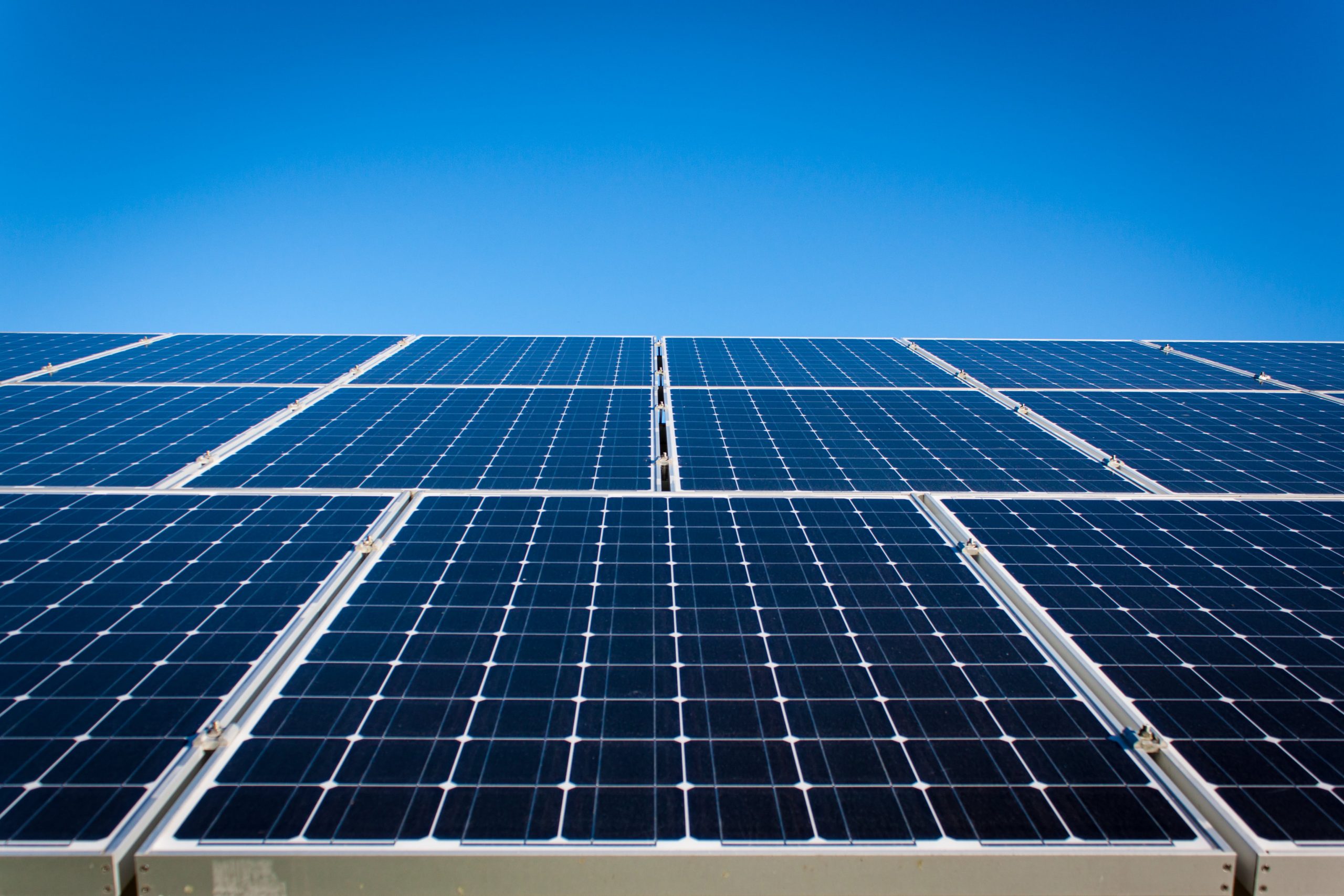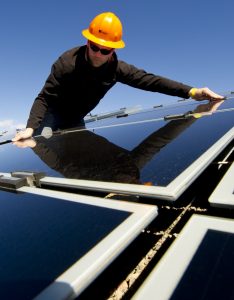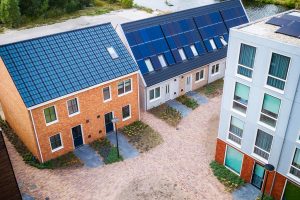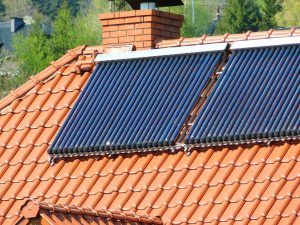PV panels
What is the difference between PV panels and regular solar panels?
The term PV panels comes from the English-speaking world and is the name for solar panels. The name comes from “Photo Voltaic. You know that ‘Photo’ means light. To make electricity from light. And “voltaic” means electricity. Literally translated into Dutch it means photovoltaic. These panels consist of photovoltaic cells that convert sunlight into electricity. These solar cells are also called pv cells, which is why the term PV panels is used.
So these panels are just solar panels that generate electricity through light. There is no difference between PV panels and solar panels, this is purely the name. Professionals and specialists in particular are sometimes tempted to use the term PV panels. Ordinary citizens use the term solar panels.
How do PV panels work?
PV panels or solar panels contain solar cells that receive light. These solar cells convert (sun) light into direct current. Because we use alternating current in our electricity network, an inverter is always needed to convert direct current into alternating current when these panels are connected to the mains. This will be the case most of the time. In those systems that use the generated power directly or store it in their own battery, an inverter is not required.
You will find the latter in garden lighting, in traffic lights or devices in use for livestock or in other traffic furniture. On average, about 12 – 16% of the sunlight will be converted into electrical energy. Meanwhile, there are already solar panels that can convert 20% of the sunlight but that is under ideal conditions. This applies to good panels that are perfectly oriented to the south at the right angle of inclination. This will not always be possible.

Several types of panels
There are now many different types of PV panels, all with their own advantages and disadvantages. Cheaper and more expensive. More beautiful or less beautiful. High yield per panel or less. And the quality of the various panels differs. You can divide the panels into the following types:
- Monocrystalline
- Polycrystalline
- Thin film
- Glass panels
To describe the different types with their advantages and disadvantages, we have listed the differences for you. You can find this information at types of panels.
What are the returns from panels?
The yield of panels depends very much on the location of the panels. They give a much higher yield in a south-facing direction than in other directions, but the angle of inclination and the location in the Netherlands also differ. In general, you can say that the closer you are to the North Sea coast, the higher the yield of the panels. If you want to know more about that read here more details.
What do PV panels cost?
What panels cost may not be the right question. A more correct question might be “What does a PV system that fits my needs cost? What will it give me in return? In how much time will I have paid back the system? To start with the last question: on average, PV systems pay for themselves in about 7 years. This is also the starting point of the subsidy scheme that the minister wants to make as a basis for the feed-in tariff after 2020.
The Salary Settlement
Meanwhile, the minister decided to extend the net metering scheme until January 1, 2023.
After that, this scheme will be phased out in steps until 2031. The balance scheme is particularly interesting because you not only get back the bare electricity price but also all associated taxes. That means an average return of about 21 cents compared to a bare electricity price of between 3 and 7 cents depending on which energy company you deliver back to. The balancing arrangement means that the power supplied is set off against the power used. In addition, various energy companies also accept the return of up to 5000 kWh for the same price. So if you have more solar panels than you need look carefully to see which energy company pays the most for your feed-in.

Investment in PV panels
More and more people are investing extensively in PV panels. Which is not surprising, it is an ideal investment for ‘free’ electricity.
And then the cost or better said height of the investment in panels. An average household uses 2910 kWh per year according to the Nibud. That means 12 solar panels with an inverter. That requires, depending on brand and type of panel, an investment of € 8,700, – including installation. The VAT you can reclaim so that about € 7,200, – remains. This set provides about € 650, – per year in electricity savings.
Waiting because the panels are constantly dropping in price is usually not wise. The sooner you invest the sooner you will be past the 7 year mark. And from that moment you have at least 18 years of free electricity. On the site of milieucentraal you will find a lot of interesting information.
Which inverter to choose?
Inverters exist in many brands, qualities and capacities. What is important, of course, is that the capacity of the inverter is sufficient to convert the maximum current that the panels can supply into alternating current which is fed into the electricity grid.
Are your panels not facing south but mainly east-west? If so, don’t take the maximum capacity of the panels as your starting point, but rather what they can supply in terms of power at the same time. In such cases, an inverter with a lower capacity, which is also cheaper, will suffice. In an east-west setup, the system starts supplying power earlier and lasts longer during the day. However, the peak capacity is a lot lower so the inverter can also be smaller. The inverter is often the most vulnerable part of the system so choose a brand with a long warranty.
There are also so-called ‘micro-inverters’. These inverters are somewhat smaller than standard inverters. They are about the size of an A5 paper (half A4).
Solar panels and insurance
Solar panels are generally covered by the building insurance. This is different if you have rented accommodation. However, it is important to know how the solar panels are installed. Insurers may have conditions attached to the insurance.
Roof fires are increasingly being caused by PV panels. Further investigation reveals that this is actually always due to the inexpert installation of these panels. During inspections of solar systems in 2018 at housing associations and companies, 50% of the systems were found to have been installed dangerously. So make sure you have a competent installer and register your systems with your fire insurance company. So that in the event of a fire, the insurer cannot claim that they did not know about the existence of the panels and that this increased the risk of fire.
PV panels are low maintenance
Solar panels require hardly any maintenance. However, it is advisable to clean or rinse the panels 1 or 2 times a year. This ensures that the efficiency remains at a high level. Solar panels have the great advantage that they have no rotating parts unlike windmills. They also provide Co2 free energy for 30 years, even on cloudy days.

Panels increase the value of your home
Solar panels contribute to an energy-neutral home. This increases the value of your home, because when you sell, the new resident has significantly lower housing costs. Also, a house with solar panels has a more favorable energy label. This energy label has been compulsory since 1 January 2015 if you want to buy, sell or rent a house. If a new buyer is not interested, you can simply take the panels with you and install them in your new home. A permit is also not required for the installation of solar panels, unless you have a monument or property that is designated as a protected town or villagescape.

Subsidy for panels
There used to be a national subsidy for PV panels. This has long ceased but some municipalities and provinces still encourage the purchase of panels. Drenthe provides a loan at a very reduced interest rate, other governments sometimes still subsidize the purchase of solar panels. More about this on the page subsidy solar panels.
Having to install panels yourself?
If you are a bit handy and not afraid of heights you could consider installing the panels yourself. This will save on installation costs and ensure that you will earn back your system even sooner than in 7 years. Make sure that the installation is done correctly and consult the professional about how to do it. The list of 10 tips that you should pay attention to can be found here.
Researching new PV panels
PV panels achieve excellent efficiencies but there is still much room for improvement. TNO is conducting research to improve the performance of the panels and believes that in time the yield could double if the costs are reduced by at least a factor of 3. TNO is a very important player worldwide in the field of solar cell innovations. More than 50% of the panels produced worldwide contain TNO technology.
Now new PV panels are based on different technologies:
- crystalline silicon
- thin film solar cells
- tandem
- two-sided PV panels
- back PV panels
The latter, tandem, is a combination of thin film cells with crystalline silicon technology.

Crystalline sill panels
95% of panels installed today are silicon-based. In flat terms, they are based on (pure) sand. These now have an
efficiency of between 16 and 21%. TNO thinks that this efficiency can be increased to 26%. It thinks this can be achieved by spraying very thin layers on the silicon. A higher efficiency than 26% is not inconceivable but then the costs will rise faster than the yield.
Thin film solar cells
An alternative to silicon panels are thin film solar cells. They are already being produced in large numbers but their efficiency is currently lower than silicon-based PV panels. Advantages of the thin film solar cells are their uniform color and their wider application. Because they are only 1 to 3 micrometers thin (compare this to the 150 micrometers of silicon panels) the thin film solar cells are much more flexible and therefore more widely applicable. TNO is now focusing its innovations on two materials: Copper Indium Gallium Selenide (CIGS) and perovskite.
Tandems
By combining the above technologies and by stacking thin film solar cells, much higher efficiencies can be achieved. It is expected that this efficiency will be 40% higher than with conventional panels. This means that the same area of panels produces 40% more or that the required area can be reduced by 40%. This is especially important on small roofs in the densely built-up Netherlands. The lower cost per kWh is also achieved because the cost of cabling is the same and therefore relatively lower per kWh. This technology is now being tested from the lab in practice in real live.
Two-sided solar panels
Normal PV panels capture sunlight on only one side. While by reflecting sunlight, energy can also be captured at the rear of the panels. This is particularly interesting because the production of two-sided solar panels is barely higher than the single variant. The additional yield is about 10 – 20% compared to the single panels. This solution is interesting for large-scale use on agricultural land, large roofs and floating solar panels. Thus, double-sided solar panels have a lower cost per kWh. TNO is a global pioneer in the field of double-sided solar panels.
Backside solar panels
Silicon PV panels have their wiring and metal covering on the front. And where there is metal, sunlight cannot be converted into electricity. Moreover, the efficiency also decreases due to shadowing of the metal. Now by moving the metal parts with junction to the back side, the efficiency increases at the front side. As a result, the metal parts are also no longer, or hardly, visible at the front.
Custom panels
Today’s silicon PV panels are made in large numbers in rectangular shapes. The size of the panels is determined by the manufacturer in a standard size. These are placed on roofs and facades if the building is already there. By using thin film solar cells, for example, it is possible to integrate solar cells into building materials such as glass, metal and various plastics at the factory. And customization is possible for use in windows, conservatories, facade elements and roofs. In these, the solar cells are manufactured completely transparent or in a specific color. In this way the surface of roofs and facades is better utilized.
The Netherlands has a total of more than 2,000 KM2 of roofs and facades. In the Solliance consortium, the applicability of this technology is being tested in practice. With TNO as project coordinator. In this way, the technology is applied to test buildings. And compared to current techniques for converting solar energy into electricity. The intention is to demonstrate that integrating customised PV systems into building materials is possible. And especially to do so aesthetically.

PV panels on a large scale
In Helmond, this concept was applied on a large scale for the first time. On a southern facade on a surface of 152 m2. On this 177 Solarix panels are attached in 3 different colors and sizes. This leads to 9 different solar panels, all custom made. Together these produce 8,600 kWh of energy which is equivalent to the power consumption of 3 households. It also saves 3.7 tons of CO2 emissions.
In addition to providing solar energy, the design solar tiles also enhance the identity and appearance of the building. Studio Solarix won the Solar Challenge of the Dutch Design Week in 2016 with this application. A combination of innovation and appearance, practically applied. In this project in Helmond, we collaborated with Kuijpers installation technology and Sorba Projects for the facade construction. The producer of the PV panels was Kameleon Solar.
In the partnership Solliance, companies, individuals, universities and other knowledge institutions work together with TNO to perfect these techniques. In the Interreg program also neighboring countries Germany and Belgium participate.
Custom made
Dutch Solar Design Photovoltaic (DSD-PV) makes it possible to print on PV panels. This gives the panels a very nice look and they are not recognizable as PV panels on the facades. In addition to beautiful prints, this printing also ensures that sufficient sunlight still reaches the underlying solar panel. In principle, it is possible to print any desired image. The algorithm of DSD-PV’s printing software ensures the right mix of appearance and transparency. Printing a dot pattern on the panel creates the optical illusion of an image. While most of the panel remains uncovered.
This technique entices architects and end users to use panels on a larger scale, especially on building facades. PV panels on facades provide less electricity in the summer than panels on the roof. On the other hand, they produce more energy in winter, when the sun is high. And in winter, that energy is needed more for heating and lighting. It also prevents overloading of the grid because the peak load of the power supply is much lower. In short, an aesthetically pleasing solution with sustainable power generation.
A pilot project with this application was conducted at STC in Amsterdam. Adowa has replaced the grids in the facade by beautiful printed PV panels. Solar Visuals made the glass-glass panels. Because Adowa used a frameless suspension system the sunlight can reach the solar panels as much as possible.
This application also has possibilities for use on sound barriers and bridges. For example, a sound barrier can be visually integrated into the landscape with a green print. This is very necessary because in the Netherlands we have decided to have an energy-neutral built environment by 2050.
Dutch Solar Design Photovoltaic is a collaboration of six partners. TNO, the Amsterdam University of Applied Sciences, consultancy Design Innovation Group, facade builder Aldowa and architectural firm UNstudio. And it is made possible by a grant from the Top Sector Energy of the Ministry of Economic Affairs.